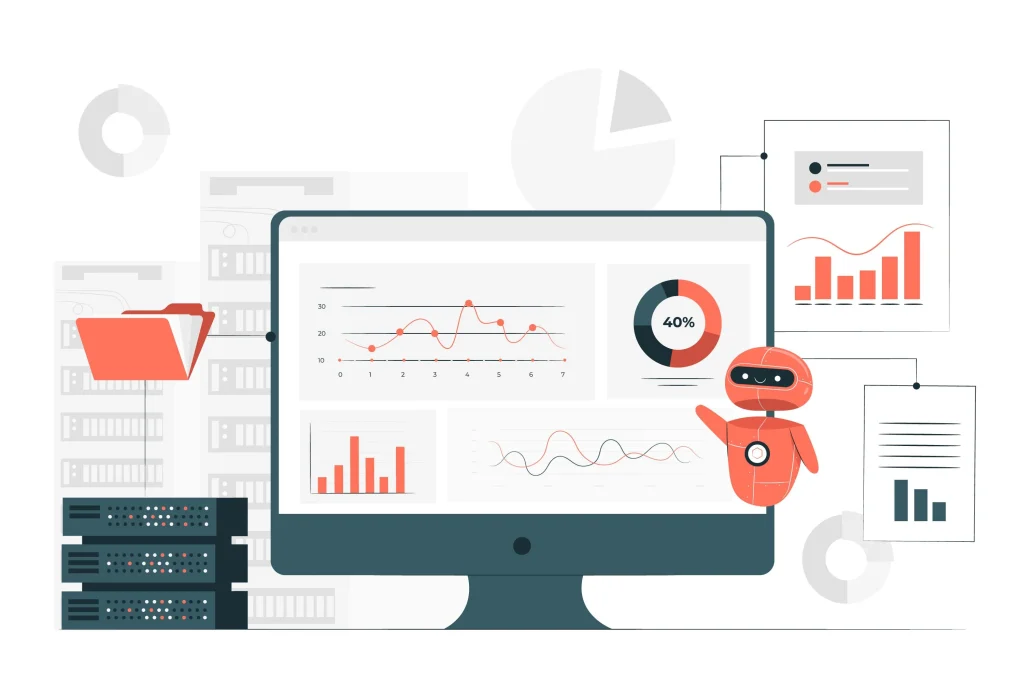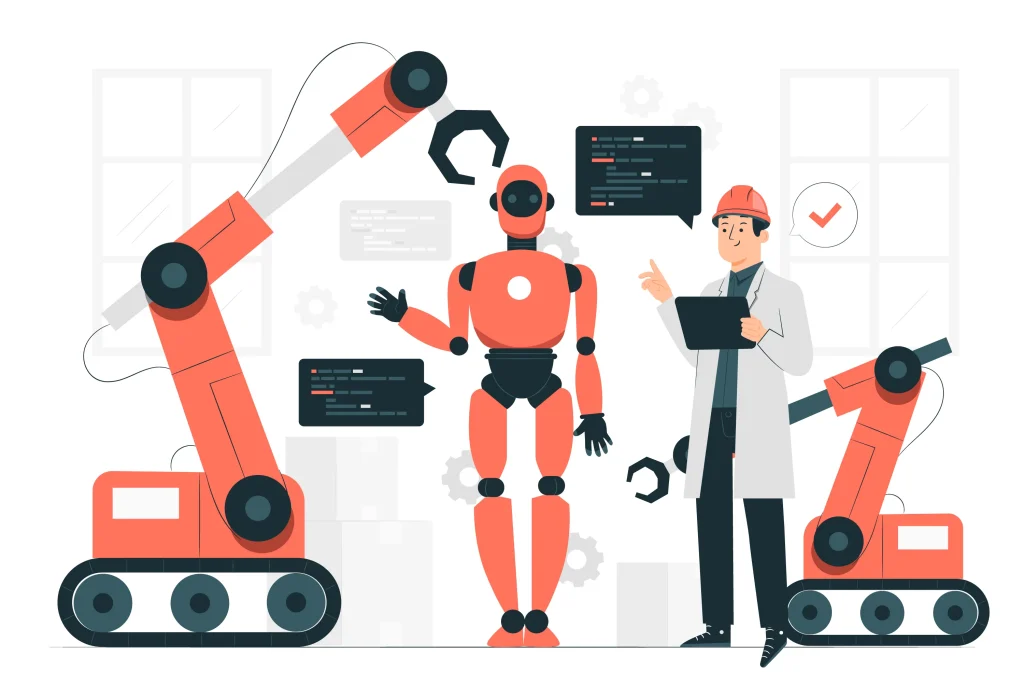
As AI algorithms and machine learning technologies evolve, recruiters find themselves at the forefront of a paradigm shift that transcends routine tasks. From automating repetitive processes to enabling data-driven decision-making, AI has become a catalyst for innovation, propelling recruitment into a dynamic and transformative phase. This article navigates through the profound changes that AI introduces, offering insights into how these advancements streamline the hiring process and contribute to building diverse, high-performing teams that drive organizational success.
Automated Resume Screening
In the ever-evolving recruitment landscape, one of the most transformative advancements is Automated Resume Screening. Traditional methods of sifting through countless resumes and applications have proven time-consuming and prone to biases. However, integrating Artificial Intelligence (AI) into this process has revolutionized how organizations identify and assess potential candidates. In this section, we will delve into the intricacies of Automated Resume Screening and its profound impact on the efficiency and effectiveness of the recruitment process.
Understanding Automated Resume Screening:
Automated Resume Screening employs cutting-edge AI technologies, such as Natural Language Processing (NLP) and machine learning algorithms, to analyze resumes and applications. This process goes beyond the limitations of manual screening, allowing for a rapid and comprehensive evaluation of candidates at scale. By recognizing keywords, relevant skills, and experience, these AI-driven tools provide recruiters with a shortlist of candidates who closely match the requirements of a given position.
The Benefits of Automated Resume Screening:
- Time Efficiency: One of the primary advantages is the significant reduction in the time required for the initial screening process. AI algorithms can swiftly analyze large volumes of resumes, enabling recruiters to focus on engaging with the most qualified candidates.
- Objective Evaluation: Automated Resume Screening minimizes the impact of subjective biases that might influence human recruiters. Relying on predefined criteria and algorithms ensures a more objective evaluation of candidate qualifications, promoting fairness and diversity in the hiring process.
- Improved Candidate Matching: AI algorithms’ precision in matching candidate profiles with job specifications ensures that recruiters are presented with candidates whose skills and experiences align closely with the role’s requirements.
While Automated Resume Screening offers numerous advantages, it’s essential to acknowledge potential challenges. Critical considerations are ensuring that the algorithms are trained on diverse datasets to avoid perpetuating biases and regularly updating them to reflect evolving job market trends.
Integrating Automated Resume Screening marks a pivotal moment in evolving recruitment practices. The ability to swiftly and objectively assess candidates accelerates the hiring process and contributes to building more diverse and qualified teams. As technology advances, organizations embracing Automated Resume Screening are better positioned to navigate the competitive talent landscape, ensuring they attract and retain the best-suited candidates for their workforce. The future of recruitment is undeniably intertwined with the power and precision of AI-driven solutions.

Enhanced Candidate Matching
The quest for the perfect candidate has been an ongoing challenge in the dynamic world of recruitment. Traditional methods often relied on subjective assessments, leading to mismatches between candidates and job requirements. However, with the integration of Artificial Intelligence (AI), the landscape of candidate matching has undergone a profound transformation. In this section, we will explore the innovative realm of Enhanced Candidate Matching and its pivotal role in reshaping the recruitment process.
Understanding Enhanced Candidate Matching:
Enhanced Candidate Matching harnesses the power of AI algorithms to perform a nuanced and comprehensive analysis of candidate profiles. Beyond conventional keyword matching, these sophisticated algorithms delve into the intricacies of a candidate’s skills, experiences, and attributes. These systems continually refine their understanding by leveraging machine learning, ensuring a more precise alignment between candidates and job specifications.
The Dynamics of Precision:
- Skill Profiling: Enhanced Candidate Matching excels in creating detailed skill profiles for candidates. By parsing through resumes and application data, AI algorithms identify not only explicit skills but also contextual understanding, allowing for a more holistic evaluation.
- Cultural Fit Assessment: Beyond technical skills, the algorithms consider cultural fit indicators, analyzing language use, communication styles, and other subtleties to gauge how well a candidate aligns with the organization’s values and work culture.
- Adaptability Evaluation: In a rapidly changing job market, the ability to adapt is paramount. Enhanced Candidate Matching algorithms dynamically assess a candidate’s adaptability by considering their experiences in diverse roles and industries.
The Advantages of Precision Matching:
- Reduction in Hiring Time: By precisely identifying candidates whose profiles closely match the job requirements, recruiters can significantly reduce the time spent on reviewing applications and conducting interviews.
- Improved Quality of Hires: Enhanced Candidate Matching contributes to a higher quality of hires by ensuring that not only technical skills but also soft skills and cultural compatibility are taken into account during the selection process.
- Enhanced Candidate Experience: Candidates benefit from a more personalized and relevant experience, as the matching algorithms provide them with opportunities that align with their skills and career aspirations.
Despite the evident advantages, challenges such as the need for diverse training data and ongoing algorithm refinement must be addressed to maintain the effectiveness of Enhanced Candidate Matching.
Enhanced Candidate Matching is a game-changer in recruitment. The precision and depth it brings to the matching process streamline hiring procedures and contribute to forming more cohesive and high-performing teams. As organizations continue to embrace AI’s capabilities, Enhanced Candidate Matching emerges as a key driver in pursuing talent that not only meets but exceeds the expectations of modern workplaces. The future of recruitment lies in the artful integration of technology to create matches as nuanced and dynamic as the candidates themselves.

Predictive Analytics for Hiring Success
In the ever-evolving talent acquisition landscape, organizations are turning to advanced technologies to gain a competitive edge in identifying and retaining top talent. One such groundbreaking technology is Predictive Analytics, a powerful tool beyond traditional hiring methods. This section delves into Predictive Analytics for Hiring Success, exploring how it reshapes the recruitment process and elevates organizations’ ability to make informed, data-driven hiring decisions.
Understanding Predictive Analytics for Hiring Success:
Predictive Analytics involves using historical data, statistical algorithms, and machine learning techniques to identify the likelihood of future outcomes. When applied to the hiring process, it enables organizations to predict candidate success based on many factors. This includes analyzing past hiring data, performance metrics, and employee outcomes to create models informing decision-makers about candidates’ potential success in specific roles.
Navigating Talent Waters with Data:
- Historical Hiring Data Analysis: Predictive Analytics analyzes historical hiring data to identify patterns and trends. This includes factors such as the success of past hires, the impact of various recruitment sources, and the correlation between candidate attributes and on-the-job performance.
- Performance Metrics Integration: By incorporating performance metrics of current employees, Predictive Analytics models refine their predictions. This allows organizations to go beyond traditional qualifications and assess how well candidates are likely to perform based on their skills, work styles, and cultural fit within the organization.
- Continuous Learning Algorithms: Predictive Analytics systems are dynamic, continually learning and adapting to changes in the job market, organizational needs, and industry trends. This adaptability ensures that predictions remain accurate and relevant over time.
The Strategic Advantages of Predictive Analytics:
- Reduced Turnover: By identifying candidates with a higher likelihood of success, organizations can reduce turnover rates. Predictive Analytics helps in making strategic hires that are more likely to thrive within the company culture and stay for the long term.
- Cost Savings: Efficient hiring decisions based on predictive models contribute to cost savings. Organizations can allocate resources more effectively, minimizing the financial impact of hiring mistakes and optimizing their recruitment strategies.
- Strategic Workforce Planning: Predictive Analytics assists in strategic workforce planning by identifying potential skill gaps and aligning hiring strategies with the long-term goals of the organization.
While Predictive Analytics offers substantial benefits, ethical considerations, such as potential biases in historical data and the responsible use of predictive models, must be carefully addressed to ensure fair and unbiased hiring practices.
The integration of Predictive Analytics for Hiring Success marks a paradigm shift in the recruitment landscape. The strategic advantages become undeniable as organizations increasingly rely on data-driven insights to inform their hiring decisions. By leveraging the power of Predictive Analytics, organizations enhance their ability to identify top talent and position themselves to thrive in an era where strategic workforce planning is crucial for sustained success. The future of hiring belongs to those who harness the predictive power of data to navigate the complex waters of talent acquisition with confidence and foresight

Chatbots for Initial Candidate Interaction
In the fast-paced world of recruitment, where time is of the essence, and candidate engagement is paramount, organizations are turning to innovative solutions to streamline the initial interaction process. Chatbots, powered by Artificial Intelligence (AI), have emerged as a transformative tool in the early stages of candidate engagement. This section delves into the realm of Chatbots for Initial Candidate Interaction, exploring how these digital assistants enhance efficiency, provide a seamless experience, and set the stage for positive candidate-employer relationships.
Understanding Chatbots in Initial Candidate Interaction:
Chatbots are AI-driven conversational interfaces designed to interact with users in a natural language format. In the context of recruitment, these digital assistants play a pivotal role in engaging with candidates during the initial stages of the application process. They can answer queries, collect basic information, and guide candidates through preliminary assessments, all while providing a personalized and responsive experience.
The Dynamic Capabilities of Chatbots:
- 24/7 Accessibility: Chatbots offer round-the-clock availability, providing candidates with the flexibility to engage with the recruitment process at their convenience. This ensures that potential applicants from various time zones or with busy schedules can initiate the application process whenever it suits them.
- Efficient Information Gathering: Chatbots excel at collecting essential information from candidates, such as basic qualifications, work history, and preferences. By automating this data collection, recruiters can focus on more strategic aspects of the hiring process, saving valuable time.
- FAQs and Information Dissemination: Chatbots are adept at addressing frequently asked questions (FAQs) and disseminating information about the company, job roles, and the application process. This not only enhances candidate understanding but also contributes to a positive and informed candidate experience.
Elevating the Candidate Experience:
- Personalized Interactions: Through the use of AI, Chatbots can personalize interactions based on candidate responses and preferences. This creates a more engaging and tailored experience, making candidates feel valued and understood.
- Seamless Application Process: Chatbots guide candidates through the initial stages of the application process, ensuring a smooth and user-friendly experience. This reduces friction in the recruitment journey and sets a positive tone for the candidate’s overall perception of the organization.
- Immediate Feedback and Acknowledgment: Candidates receive immediate feedback and acknowledgment during interactions with Chatbots, contributing to a responsive and transparent recruitment process. This real-time engagement fosters a sense of connection between candidates and the hiring organization.
While Chatbots offer numerous benefits, organizations must address challenges such as ensuring accuracy in responses, minimizing biases in conversational interactions, and continually improving the system based on user feedback.
Chatbots for Initial Candidate Interaction represent a transformative force in the recruitment landscape. By leveraging the capabilities of AI-driven conversational interfaces, organizations enhance efficiency and elevate the candidate experience from the beginning. The dynamic and responsive nature of Chatbots sets the stage for positive candidate-employer relationships, paving the way for a more streamlined and engaging recruitment process. As technology continues to evolve, the integration of Chatbots is poised to play an increasingly vital role in creating a seamless and candidate-centric approach to talent acquisition.

Virtual Reality (VR) Job Previews
As the demands of the modern workforce evolve, organizations seek innovative ways to attract and engage top talent. In this quest, Virtual Reality (VR) has emerged as a game-changer, offering a transformative approach to the recruitment process. One standout application of VR in recruitment is through immersive job previews. This section explores the profound impact of VR Job Previews, revealing how this technology provides candidates with a glimpse into their potential roles and reshapes the recruitment experience.
Understanding VR Job Previews:
VR Job Previews leverages virtual reality technology to offer candidates a simulated and immersive experience of a typical day in the role they are applying for. Through VR headsets, candidates can explore work environments, interact with colleagues, and even engage in simulated tasks relevant to the position. This goes beyond traditional job descriptions or video interviews, providing candidates with a firsthand, realistic preview of their potential workplace.
The Immersive Journey:
- Exploration of Workspaces: VR allows candidates to explore workspaces virtually, gaining a 360-degree view of their potential office environments. This showcases physical layouts and highlights aspects like office culture, collaboration spaces, and amenities.
- Simulated Work Tasks: Candidates can engage in simulated work tasks specific to the role they are applying for. This hands-on experience provides a tangible understanding of job responsibilities, fostering a more informed decision-making process.
- Virtual Team Interactions: VR Job Previews enable candidates to virtually interact with potential colleagues and team members. This virtual team interaction goes beyond traditional interviews, giving candidates a sense of the team dynamics and company culture.
Benefits for Candidates and Employers:
- Informed Decision-Making: Candidates can make more informed decisions about their fit within the organization by experiencing the work environment and tasks firsthand, reducing the likelihood of mismatches.
- Enhanced Candidate Engagement: VR Job Previews create a memorable and engaging experience, leaving a lasting impression on candidates. This positive engagement contributes to a stronger employer brand and increases the likelihood of attracting top talent.
- Time and Cost Savings: While providing an immersive experience, VR Job Previews can save candidates and employers time and costs associated with traditional on-site visits.
Despite the numerous advantages, challenges such as the initial investment in VR technology and ensuring accessibility for all candidates must be carefully considered. Organizations must also address potential biases in the VR experience to ensure fairness in the recruitment process.
Virtual Reality Job Previews represent a groundbreaking approach to talent acquisition. By leveraging VR technology’s immersive capabilities, organizations can attract top talent and provide candidates with a unique and realistic preview of their potential roles. As the job market becomes increasingly competitive, the use of VR in recruitment stands as a testament to the commitment of organizations to create a transparent, engaging, and future-forward recruitment process. The integration of VR Job Previews heralds a new era where candidates can step into their prospective roles before making career-defining decisions, setting the stage for a more personalized and informed recruitment experience.

Bias Reduction in Hiring Decisions
In building diverse and inclusive workplaces, organizations increasingly turn to technology to address biases that may inadvertently creep into the hiring process. One powerful tool in this endeavor is Artificial Intelligence (AI), which is pivotal in reducing biases in hiring decisions. This section delves into the significance of Bias Reduction in Hiring Decisions, exploring how AI algorithms contribute to fairer, more equitable recruitment processes.
Understanding Bias Reduction in Hiring Decisions:
Bias in hiring can take various forms, including gender, racial, or socioeconomic biases. These biases can influence decision-makers at different stages of the recruitment process, from resume screening to interview evaluations. AI technologies with sophisticated algorithms and machine learning capabilities are designed to minimize these biases by focusing on objective data rather than subjective judgments.
The Role of AI in Bias Reduction:
- Objective Resume Screening: AI-driven resume screening tools analyze resumes based on objective criteria, such as skills and qualifications, eliminating biases related to gender, ethnicity, or other personal characteristics.
- Anonymous Candidate Evaluation: Some AI tools facilitate anonymous candidate evaluations by removing identifiable information from resumes and applications. This ensures that initial assessments are based solely on merit, without influence from demographic factors.
- Fair Interviewing Techniques: AI-powered interview tools are designed to standardize the interview process. By asking consistent, job-related questions to all candidates, these tools help eliminate biases that may arise from subjective or inconsistent questioning.
Advantages of Bias Reduction in Hiring:
- Diverse and Inclusive Workforce: By mitigating biases, organizations are better positioned to build diverse and inclusive workforces. AI contributes to creating environments where talent is recognized and valued irrespective of demographic factors.
- Improved Hiring Accuracy: AI algorithms focus on relevant job-related factors, leading to more accurate assessments of candidates. This ensures that hiring decisions are based on the candidate’s abilities, skills, and qualifications rather than extraneous factors.
- Enhanced Employer Brand: Demonstrating a commitment to bias reduction through AI technologies enhances an organization’s employer brand. Candidates are more likely to engage with companies that prioritize fairness and equality in their hiring processes.
While AI presents promising solutions, it’s crucial to acknowledge challenges such as potential algorithmic biases and the need for continuous monitoring and refinement to ensure fairness. Ethical considerations, transparency, and ongoing evaluations are essential components of responsible AI implementation.
Bias Reduction in Hiring Decisions through AI marks a significant stride toward creating fairer and more equitable recruitment processes. As organizations strive to build diverse and inclusive workplaces, leveraging AI to minimize biases becomes a strategic imperative. Technology integration in hiring contributes to more objective and accurate decision-making. It reinforces an organizational commitment to fostering a workplace where talent is recognized and valued on its merits. The future of hiring is undoubtedly intertwined with the responsible use of AI, paving the way for a more inclusive and unbiased professional landscape.

Continuous Employee Monitoring and Feedback
In the ever-evolving landscape of talent management, organizations increasingly recognize the value of continuous employee monitoring and feedback as crucial for employee growth and organizational success. This section explores the significance of embracing a continuous feedback culture, leveraging technological advancements, and fostering a dynamic environment where employees can thrive and contribute to their fullest potential.
Understanding Continuous Employee Monitoring and Feedback:
Continuous employee monitoring involves the ongoing observation and assessment of employees’ performance, skills, and organizational contributions. This process is complemented by continuous feedback, which provides employees with regular, timely, and constructive insights into their work, allowing them to make necessary improvements and align their efforts with organizational goals.
The Dynamic Nature of Continuous Monitoring and Feedback:
- Real-time Performance Tracking: Continuous monitoring utilizes technology to track and evaluate employee performance in real time, providing a comprehensive understanding of their contributions and areas for improvement.
- 360-Degree Feedback Systems: These systems gather insights from various sources, including peers, managers, and subordinates, providing a holistic view of an employee’s strengths and areas requiring development. This multi-perspective approach enhances the accuracy and depth of feedback.
- Goal Alignment and Progress Tracking: Continuous feedback facilitates the alignment of individual goals with organizational objectives. Regular check-ins enable employees to track their progress, make adjustments, and ensure their contributions are in sync with the evolving needs of the organization.
Advantages of Continuous Monitoring and Feedback:
- Professional Development: Employees benefit from continuous insights that aid their professional development. Identifying strengths and areas for improvement allows for targeted skill development and career growth.
- Increased Employee Engagement: Regular feedback fosters a culture of open communication and employee engagement. When their contributions are acknowledged, employees feel valued and empowered, leading to higher levels of job satisfaction.
- Enhanced Organizational Performance: By continuously monitoring and providing feedback, organizations can address performance issues promptly, optimize team dynamics, and align individual efforts with overarching organizational goals, leading to improved overall performance.
Addressing concerns related to privacy, transparency, and the potential for misuse of continuous monitoring systems is crucial. Organizations must prioritize ethical considerations to build a culture of trust and collaboration.
Integrating continuous employee monitoring and feedback represents a paradigm shift in talent management. Embracing a culture of continuous feedback is not just a performance management strategy but a commitment to employee development and organizational excellence. As organizations navigate the complexities of the modern workplace, adopting technology-driven monitoring and feedback systems becomes essential for creating dynamic, agile, and engaged teams. The future of work belongs to those who recognize the transformative power of continuous monitoring and feedback, harnessing it to unlock the full potential of their workforce and drive sustained success.

Personalized Candidate Experience
Organizations increasingly realize the importance of providing a personalized candidate experience in the competitive talent acquisition landscape. This shift goes beyond traditional one-size-fits-all recruitment approaches, emphasizing the need to tailor interactions and communications to each candidate’s unique preferences and needs. This section explores the significance of Personalized Candidate Experiences, highlighting how organizations can create meaningful connections and stand out in the eyes of potential talent.
Understanding Personalized Candidate Experiences:
Personalized candidate experiences involve customizing the recruitment journey to align with the individual preferences, skills, and aspirations of each candidate. This approach leverages technology, data analytics, and thoughtful communication strategies to create a tailored and engaging recruitment process.
Elements of Personalized Candidate Experiences:
- Customized Communication: Personalized emails, messages, and other forms of communication ensure that candidates receive relevant information about job opportunities, company culture, and the recruitment process based on their interests and qualifications.
- Tailored Job Recommendations: AI-driven algorithms analyze candidate profiles and preferences to provide personalized job recommendations. This not only saves time for candidates but also increases the likelihood of matching them with roles that align with their skills and career goals.
- Interactive and Immersive Content: Employing interactive content such as virtual tours, day-in-the-life videos, and VR experiences allows candidates to explore the workplace and job roles in a personalized and engaging manner.
Advantages of Personalized Candidate Experiences:
- Enhanced Candidate Engagement: Personalization fosters a deeper level of engagement as candidates feel that their unique skills and aspirations are acknowledged and valued by the organization.
- Improved Candidate Conversion Rates: Candidates are more likely to proceed with the application process when they feel a personal connection with the organization. This can lead to higher conversion rates and a more robust talent pipeline.
- Positive Employer Branding: Organizations prioritizing personalized candidate experiences contribute to a positive employer brand. Word-of-mouth endorsements and positive experiences candidates share can enhance an organization’s reputation in the talent market.
Organizations must navigate challenges related to data privacy, ensuring that personalization technology aligns with ethical standards and regulations. Additionally, balancing personalization and automation is essential to avoid overwhelming candidates with excessive information.
The era of personalized candidate experiences marks a significant evolution in recruitment strategies. As organizations strive to attract and retain top talent, the ability to create meaningful connections through tailored interactions becomes a competitive advantage. By leveraging technology and adopting a candidate-centric approach, organizations can position themselves as employers of choice, fostering long-term relationships with candidates and building a workforce that aligns seamlessly with their values and goals. The future of talent acquisition belongs to those who master the art of crafting personalized candidate experiences, turning recruitment into a journey of mutual understanding and shared success.

Skill Gap Analysis
In a rapidly evolving job market, where technological advancements and industry shifts reshape skill requirements, organizations face the challenge of ensuring their workforce remains equipped with the right skills. Skill Gap Analysis has emerged as a strategic tool to bridge the divide between current skill sets and the evolving demands of the workplace. This section explores the significance of Skill Gap Analysis in talent acquisition, shedding light on how organizations can proactively address skill deficiencies and optimize their workforce for success.
Understanding Skill Gap Analysis:
Skill Gap Analysis involves evaluating the skills possessed by the existing workforce against the skills required for current and future roles within the organization. This process identifies disparities, allowing employers to implement targeted training and development initiatives, hire strategically, and ensure a workforce that meets the evolving needs of the business.
The Dynamics of Skill Gap Analysis:
- Identification of Current Skills: Assessing the skills currently present within the workforce provides a baseline for understanding the organization’s strengths and potential areas for improvement.
- Anticipation of Future Skill Needs: By staying informed about industry trends and technological advancements, organizations can anticipate the skills that will be crucial in the future and align their workforce accordingly.
- Mapping Skill Requirements to Roles: Defining the skills required for specific roles enables organizations to create a comprehensive map of skill expectations, facilitating targeted recruitment efforts and talent development initiatives.
Strategic Advantages of Skill Gap Analysis:
- Strategic Workforce Planning: Skill Gap Analysis aids in strategic workforce planning, ensuring that the organization has the right talent with the right skills at the right time to meet business objectives.
- Optimized Recruitment Strategies: Understanding skill gaps allows organizations to refine their recruitment strategies, targeting candidates with the specific skills needed to fill identified gaps and contribute to organizational success.
- Enhanced Employee Engagement: Proactively addressing skill gaps through training and development initiatives enhances employee engagement, as employees feel supported in their professional growth and are better equipped to meet evolving challenges.
Organizations must navigate challenges such as the rapid pace of skill evolution, the need for continuous analysis, and the importance of balancing internal development with external hiring to address skill gaps effectively.
Skill Gap Analysis is a linchpin in forward-thinking organizations’ talent acquisition and management strategy. As the business landscape evolves, those adept at identifying, addressing, and leveraging skill gaps will emerge as industry leaders. By prioritizing Skill Gap Analysis, organizations not only future-proof their workforce but also create an environment where employees are empowered to grow, adapt, and contribute meaningfully to the organization’s success. The strategic application of Skill Gap Analysis is a cornerstone for organizations committed to navigating the ever-changing currents of the modern workforce.

Remote Recruitment Facilitation
The recruitment landscape has undergone a profound shift in the wake of digital transformation and the increasing prevalence of remote work. Remote Recruitment Facilitation has emerged as a vital strategy for organizations aiming to access a global talent pool, streamline processes, and adapt to the changing work dynamics. This section explores the intricacies of Remote Recruitment Facilitation, shedding light on how organizations can harness technology to attract, assess, and onboard talent from anywhere in the world.
Understanding Remote Recruitment Facilitation:
Remote Recruitment Facilitation involves the use of technology and digital tools to manage the end-to-end recruitment process for candidates who may be geographically dispersed. From sourcing and interviewing to onboarding, this approach transcends traditional boundaries, enabling organizations to tap into diverse talent pools and foster a flexible, global workforce.
Key Components of Remote Recruitment Facilitation:
- Virtual Job Fairs and Networking Events:
- Leverage online platforms to host virtual job fairs, connecting employers with potential candidates from around the world.
- Facilitate networking through virtual events, allowing candidates to interact with hiring managers and understand organizational culture.
- Digital Interviewing Platforms:
- Utilize video interviewing tools for initial assessments, enabling recruiters to evaluate candidates’ communication skills, professionalism, and cultural fit remotely.
- Implement asynchronous interviews to accommodate different time zones and scheduling constraints.
- Collaborative Applicant Tracking Systems (ATS):
- Adopt cloud-based ATS platforms that facilitate seamless collaboration among remote hiring teams.
- Ensure real-time visibility into candidate progress and feedback, promoting efficient decision-making.
Advantages of Remote Recruitment Facilitation:
- Global Talent Access:
- Break down geographical barriers to access a diverse talent pool, bringing in candidates with varied skills and perspectives.
- Tap into specialized skills that may not be readily available in a local market.
- Cost and Time Efficiency:
- Reduce recruitment costs associated with travel, accommodation, and physical infrastructure.
- Expedite the hiring process by leveraging digital tools for assessments and interviews.
- Flexibility and Inclusivity:
- Offer a flexible and inclusive recruitment process, accommodating candidates with various needs and preferences.
- Promote diversity by creating a level playing field for candidates regardless of their location.
Organizations must address challenges related to cultural differences, time zone management, and ensuring that remote onboarding processes effectively integrate new hires into the organizational culture.
Remote Recruitment Facilitation is a transformative approach in the modern recruitment landscape. As organizations embrace the possibilities of a globalized workforce, the ability to facilitate recruitment processes remotely becomes a strategic imperative. Leveraging digital tools and technology not only expands access to talent but also enhances efficiency and flexibility in the hiring process. The future of recruitment lies in organizations that can adeptly navigate the complexities of remote facilitation, attracting, assessing, and integrating top talent from every corner of the globe. The journey towards a globalized and remote-friendly workforce is propelled by the seamless integration of Remote Recruitment Facilitation into the core strategies of forward-thinking organizations.
Conclusion
In the wake of the digital revolution, the transformative impact of AI on recruiting is evident in the recalibration of traditional hiring practices. The 10 key changes brought forth by AI herald a future where efficiency, objectivity, and strategic talent acquisition are paramount. As organizations embrace the capabilities of AI, they position themselves not just as early adopters of technology but as pioneers in crafting a recruitment landscape that is both agile and intelligent.
The journey towards an AI-driven recruitment future is marked by continuous adaptation, learning, and ethical considerations. By harnessing the power of AI to augment human decision-making, organizations can create a synergy that goes beyond routine tasks, enabling recruiters to focus on strategic, value-driven initiatives. As the recruitment landscape evolves, the transformative impact of AI serves as a beacon guiding organizations towards a future where talent acquisition is not just a process but a strategic advantage in the pursuit of organizational excellence.
This article was created by the FirstHR team. You can find even more helpful HR tips in the Guides section. In the Template section we have prepared for you the most popular HR documents that you can download for free. Enjoy!





